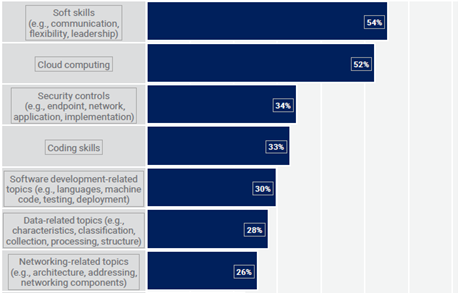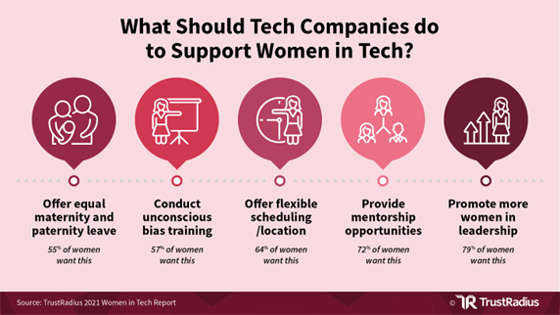It wasn’t long ago that the first women began to enter the technology field, specifically in computer science and information technology. In the late 1960s, formidable women began to shape and steer the tech field, creating operating systems and developing programming languages. Heading the MIT Instrumentation Lab and the Office of Computer Information at the National Bureau of Standards. Earning PhDs in computer science and authoring groundbreaking textbooks, and distinguishing themselves in other historic ways.
These pioneers opened doors for a growing population of women interested in science, technology, engineering, and mathematics. Perhaps without realizing it, they helped to launch the STEM revolution and laid a foundation for future generations of women.
Recent History
 Since those exciting milestone moments, enough water has flowed under that bridge to fill the Mediterranean. Have women advanced significantly? Is our current state a matter of pride or frustration? Do opportunities still exist for women in tech? What obstacles stand in the way?
Since those exciting milestone moments, enough water has flowed under that bridge to fill the Mediterranean. Have women advanced significantly? Is our current state a matter of pride or frustration? Do opportunities still exist for women in tech? What obstacles stand in the way?
In 1996, a study of U.S. college freshmen by the Higher Education Research Institute indicated that one-fifth of men (20%) intended to major in computer science and engineering. By comparison, only 4% of women planned to major in these fields.
In 2015, women accounted for almost half (47%) of all employed adults in the U.S. However, they held only 25% of computing roles, according to the National Center for Women & Information Technology. All things being equal, they should have occupied 47% of computing roles.
According to 2018 Pew Research Center data, employment in the U.S. has grown 34% since 1990. However—and brace yourself—STEM jobs have grown by 79% in the same timeframe! Tech jobs are booming. Today, in the face of constantly evolving cyber threats, they continue to boom.
The following year, a 2019 article in CIO Magazine noted that “despite national conversations about the lack of diversity in tech, women are disproportionally missing out on this boom.”
The Current State of Cybersecurity, and Opportunities for Women
This year, ISACA released its 8th Annual State of Cybersecurity report based on its 2021 survey. While not specifically spotlighting women in tech, the report does provide insights into the state of cybersecurity in 2021 and its impact on organizations. The challenges of finding and keeping tech professionals are front and center, along with technology skills gaps and tech budgets. We’ve shared the results below, and pointed out how some of these challenges can create opportunities for women in tech.
Retaining Employees
- In addition to countless other fields and industries, cybersecurity has been affected by the pandemic-driven Great Resignation. Companies are engaged in a dire battle to hang on to their cybersecurity staff, with 60% reporting difficulty retaining qualified cybersecurity professionals. That’s a 7-point increase from 2020's 53%.
- Most alarmingly, resignation rates among mid-career employees (aged 30 to 45, typically well-experienced) jumped 20% in a single year, from 2020 to 2021, according to an article in the Harvard Review.
Opportunity: Employee attrition at these levels presents an opportunity for women in tech who are willing to remain with their organizations, especially if they are able to distinguish themselves in their work, their experience, or their expertise.
Filling Vacancies
- 63% of ISACA survey respondents have unfilled cybersecurity positions, up eight points from last year’s 55%.
- In determining whether a candidate is qualified, prior hands-on cybersecurity experience remains the primary factor (73%). Although more companies are waiving college degree requirements for entry-level cybersecurity staff, it typically takes three to six months to fill an open position.
Opportunity: Unfilled vacancies also present opportunities for women in tech, particularly those who have hands-on experience, regardless of whether they have a college degree. In lieu of a degree, cybersecurity-related and industry certifications can provide a distinct advantage.
Skills Gaps

- Soft skills (communication, flexibility, leadership) and cloud-computing skills are the top two skill gaps found among today’s cybersecurity professionals (54% and 52% respectively).
- Other notable gaps include security controls; coding skills; software development topics such as languages, machine code, testing, and deployment; data-related topics such as characteristics, classification, collection, processing, and structure; and networking-related topics such as architecture, addressing, and networking components.
- To address these gaps, organizations are cross-training employees and increasing the use of contractors and consultants, as their primary tools.
Opportunity: The skills gap can provide opportunities for women in tech, especially those who have earned relevant certifications and industry credentials. In addition, acquiring good communications skills, leadership skills, and cloud computing expertise can add high value. And if hands-on experience is short, having course credits for training in these areas is a competitive advantage for women.
Within organizations, financial resources are needed to help resolve most of these issues, and the outlook is surprisingly positive. The number of survey respondents who believe their cybersecurity programs are properly funded increased to 42% in 2021—up five points from 2020’s 37%. In addition, more than half (55%) expect to see budgets increase. This, too, should translate into opportunities for women to enter or advance in technology roles.
Women’s Experiences in Tech

A recent Women in Tech report, produced annually by TrustRadius, has published results specific to women’s experiences in technology roles. They include:
- Women in tech are nearly twice as likely as men to have lost their jobs, or to have been furloughed, due to the pandemic. 57% of women feel burned out, as compared to 36% of men, and a noted contributing factor is the dual burden of household management and full-time work that typically falls on women more than men.
- In business meetings, almost three-quarters of women in tech (72%) are regularly outnumbered by men by at least a 2:1 ratio. One-quarter of women (26%) report being outnumbered by 5:1 or more.
- 78% of women in tech feel they have to work harder than their male coworkers to prove their worth. As Ginger Rogers once famously observed, she did everything that Fred Astaire did, but backwards and in high-heels. Most women in tech today seem to share that point of view.
The women surveyed for the Women in Tech report offered several recommendations for organizations to address these and similar disparities. They include these six:
- Promoting more women into leadership positions (78%)
- Providing mentorship opportunities (72%)
- Offering flexible scheduling (64%)
- Conducting ‘unconscious bias’ training (57%)
- Offering equal maternity and paternity leave (55%).
One Woman’s Inspiration
Rema Deo, CEO and Managing Director of 24By7Security, was recently interviewed for an article on the Payment Card Industry’s Security Standards Council website. Titled “Paving the Way: Inspiring Women in Payments,” the interview elicits observations and insights from Rema based on her extensive cybersecurity and payment industry experience.
Rema actively mentors the women technologists and security professionals at 24By7Security and is a recognized role model for women in technology both inside and outside the company. She won a 2021 Cyber Security Global Excellence Award in the Women in Cyber and Info Security category.
Asked about the number of women in technology, Rema replied as follows:

“While I see our numbers growing, the percentage of women in technology management is still low. Women make up about 25% of the tech industry workforce, but just over 20% of tech leadership roles are held by women. Gender discrimination in male-dominated workplaces is still influential in discouraging women from technology roles. In addition, women continue to take on the lion’s share of childcare and household responsibilities, and therefore are likely to experience burnout more often than men.”
In addition to numerous cybersecurity and compliance certifications, Rema is a PCI Qualified Security Assessor (QSA), authorized by the PCI Security Standards Council to assess payment industry members’ compliance with the PCI Data Security Standard and its 12 detailed requirements. Her company offers compliance assessments, readiness evaluations, and gap analyses to guide merchants and payment card organizations in safeguarding cardholder data by meeting the requirements.
When asked what advice she might impart to other women about how to succeed in the payment industry or in any technology-based field, Rema offered this specific guidance:
“Certifications help increase credibility in the technology arena and can really help boost your career because they are recognized industry standards. Also, seek out mentors who you think will give you unbiased advice. If I had to give my younger self advice, I would have forced myself to network with others more, even if it took me out of my comfort zone. Building a strong professional network is essential to growth in business today.”
To learn more about Rema Deo’s individual journey in technology and cybersecurity, read the entire interview on the PCI SSC website.
Summary
In the 1960s, women first entered the computer science and information technology fields in a remarkable way. Some 60 years later, great strides have been made, as the numbers show.
However, challenges still abound in the tech industry, despite anti-discrimination laws, corporate gender parity programs, and benchmark surveys that monitor progress. Opportunities do exist for women in tech who are willing to recognize them and work harder than men to take advantage of them.








